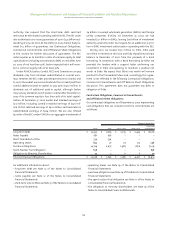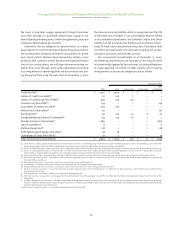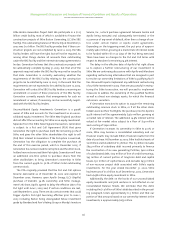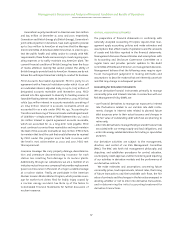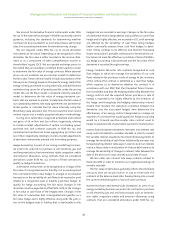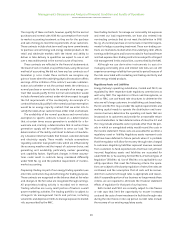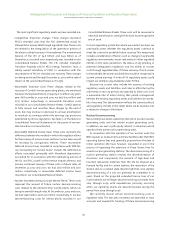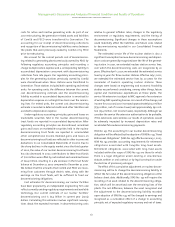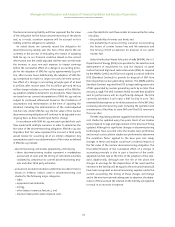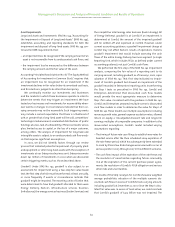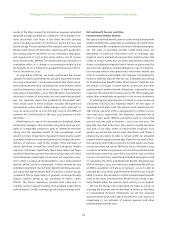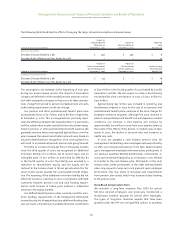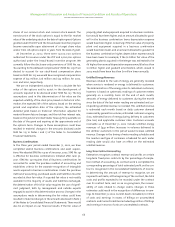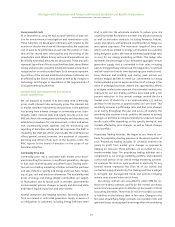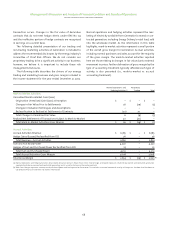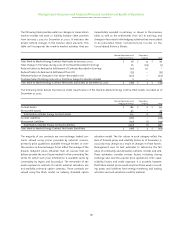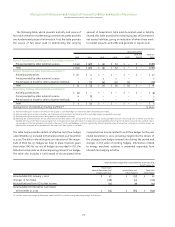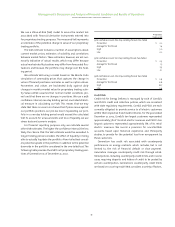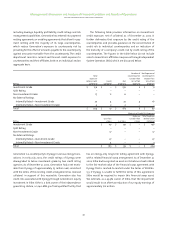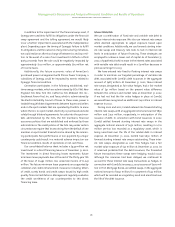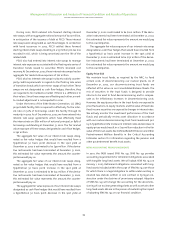ComEd 2002 Annual Report Download - page 66
Download and view the complete annual report
Please find page 66 of the 2002 ComEd annual report below. You can navigate through the pages in the report by either clicking on the pages listed below, or by using the keyword search tool below to find specific information within the annual report.
64
results of the Step I analysis for Enterprises,however,calculated
weighted average probabilistic valuations of the multiple sce-
nario discounted cash flows of less than the book carrying
value, including goodwill, of InfraSource, Exelon Services and
Exelon Energy.The second step of the analysis,which compared
the fair value of each of Enterprises’reporting units’goodwill to
the carrying value at December 31, 2001,indicated a total good-
will impairment of $357 million ($243 million, net of income
taxes and minority interest).The impairment was recorded as a
cumulative effect of a change in accounting principle in the
first quarter of 2002.Enterprises’goodwill balance was $76 mil-
lion at December 31, 2002.
As required by SFAS No. 142, Exelon performed the annual
update of ComEd’s and Enterprises’goodwill impairmentanaly-
ses using a November 1, 2002 measurement date. These valua-
tions determined the Step I calculated fair value of both ComEd
and the Enterprises’ units to be in excess of their respective
book values at November 1,2002. Since the Step I calculated fair
value was in excess of book value, we concluded that goodwill
was not impaired. Again, the probabilistic discounted cash
flows model used in these analyses included the significant
assumptions noted above. Rate changes were assumed to
occur at various points in 2007 through 2009 in the different
scenarios for ComEd based on the June 2002 extension of the
rate freeze.
Modifications to any of the assumptions discussed above,
particularly changes in discount rates,long-term earnings mul-
tiples of comparable companies used to determine terminal
values, and the expected results of rate proceedings, could
result in a future impairment of goodwill.Actual results as well
as market conditions in upcoming periods will impact the prob-
abilities of scenarios used in the models. If the estimates of
future cash flows in both the ComEd and Enterprises models
had been 10% lower, respectively, those discounted cash flows
would still have been greater than the carrying values of ComEd
and Enterprises, respectively. As we were not required to per-
form a Step II analysis at the November 1, 2002 measurement
date for either ComEd or Enterprises, a dollar amount for any
potential impairment has not been determined. Because good-
will represents approximately 85% of ComEd’s common equity,
a potential future impairment of goodwill could significantly
impact ComEd’s ability to pay dividends to Exelon under
PUHCA. The Illinois legislation provides that reductions to
ComEd’s common equity resulting from goodwill impairments
will not impact ComEd’s earnings cap calculation through 2006.
Defined Benefit Pension and Other
Postretirement Welfare Benefits
We sponsor defined benefit pension plans and postretirement
welfare benefit plans applicable to essentially all ComEd, PECO,
Generation and BSC employees and certain Enterprises employ-
ees. The costs of providing benefits under these plans are
dependent on historical information such as employee age,
length of service and level of compensation,and the actual rate
of return on plan assets. Also, we utilize assumptions about the
future,including the expected rate of return on plan assets, the
discount rate applied to benefit obligations, rate of compensa-
tion increase and the anticipated rate of increase in health care
costs.In accordance with SFAS No.87,“Employer’s Accounting for
Pensions”(SFAS No.87) and SFAS No.106,“Employers’Accounting
for Postretirement Benefits Other than Pensions”(SFAS No. 106)
the impact of changes in these factors on pension and other
postretirement welfare benefit obligations is generally recog-
nized over the expected remaining service life of the employees
rather than immediately recognized in the income statement.
In selecting the expected rate of return on plan assets, we
considered historical and expected returns for the types of
investments the plans hold. Our pension trust assets have lost
$581 million, and $265 million, and gained $173 million in 2002,
2001 and 2000, respectively. The long-term expected rate of
return on plan assets (EROA) assumption used in calculating
pension cost was 9.5% at January 1, 2002, 2001 and 2000. We
generally maintain 60% of our plan assets in equity securities
and 40% of our plan assets in fixed-income securities. Each
quarter we review the actual asset allocations and follow a
rebalancing procedure in order to remain within an allowable
range of these targeted percentages. Based on our asset alloca-
tion and long-term historical returns for both equity and fixed-
income securities,we set our EROA at 9.0% as of January 1,2003
in order to calculate 2003 pension cost.Our other postretirement
benefit assets have lost $125 million, $14 million and $7 million
in 2002,2001 and 2000,respectively.The EROA assumption used
in calculating the other postretirement benefit obligation was
8.8% at January 1, 2002,2001 and 2000,respectively.We will use
an EROA assumption of 8.4% as of January 1, 2003 in order to
calculate the 2003 other postretirement benefit costs. A lower
EROA is used in the calculation of other postretirement benefit
costs as the other postretirement benefit trust activity is par-
tially taxable while the pension trust activity is non-taxable.
We use the Moody’s Aa Corporate Bond Index as a basis in
selecting the discount rate. As described in Note 15 of the Notes
to Consolidated Financial Statements, we set the assumed
discount rate at 7.35% and 6.75% at December 31,2001 and 2002,
respectively, in our estimate of pension expense and other
postretirement benefit costs.
Management’s Discussion and Analysis of Financial Condition and Results of Operations
exelon corporation and subsidiary companies


